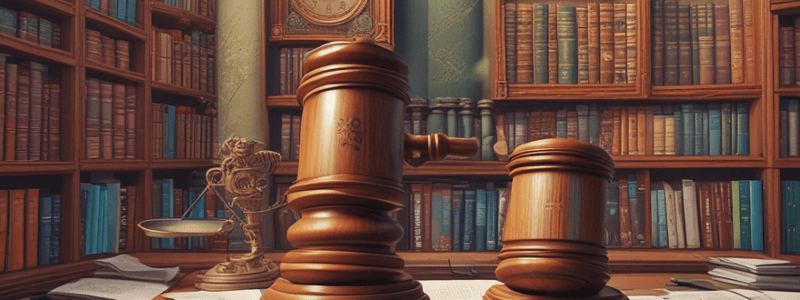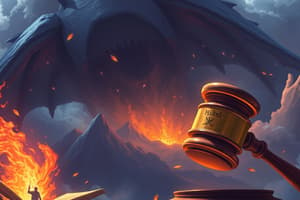Podcast
Questions and Answers
Which of the following best describes the issue in this case?
Which of the following best describes the issue in this case?
- Whether the leadership dispute within the Traditional Cat Association (TCA) was justified.
- Whether the statute of limitations for defamation claims varies based on the medium of publication.
- Whether the Traditional Cat Association (TCA) had the right to create a website criticizing Fineran and TTCA.
- Whether the single-publication rule applies to defamatory statements made on an Internet website. (correct)
What was the court's holding in this case?
What was the court's holding in this case?
- The single-publication rule applies to Internet publications, and the defamation claim was barred by the statute of limitations. (correct)
- The single-publication rule applies to Internet publications, but the defamation claim was not barred by the statute of limitations.
- The single-publication rule does not apply to Internet publications.
- The court did not make a definitive ruling on the applicability of the single-publication rule to Internet publications.
Which of the following best describes the reasoning behind the court's decision?
Which of the following best describes the reasoning behind the court's decision?
- The court aimed to discourage the creation of websites criticizing individuals or organizations.
- The court recognized the similarities between web content and traditional mass media, and the need to protect publishers from continuous liability. (correct)
- The court determined that the statute of limitations for defamation claims should be extended for Internet publications.
- The court prioritized the free dissemination of information over potential defamation claims.
What is the purpose of the single-publication rule?
What is the purpose of the single-publication rule?
Which of the following statements best summarizes the court's reasoning for extending the single-publication rule to Internet publications?
Which of the following statements best summarizes the court's reasoning for extending the single-publication rule to Internet publications?
According to the court's reasoning, which of the following is a potential consequence of not applying the single-publication rule to Internet publications?
According to the court's reasoning, which of the following is a potential consequence of not applying the single-publication rule to Internet publications?
What was the main reason the court found the defenses insufficient in this case?
What was the main reason the court found the defenses insufficient in this case?
Why did the court emphasize the precision required in a defense of truth in libel cases?
Why did the court emphasize the precision required in a defense of truth in libel cases?
What did the Court of Appeals do regarding the Appellate Division's order?
What did the Court of Appeals do regarding the Appellate Division's order?
What type of evidence is required to mitigate damages in a libel case?
What type of evidence is required to mitigate damages in a libel case?
How did the court view substantial truth in this case compared to legal terms?
How did the court view substantial truth in this case compared to legal terms?
What aspect of a defense of truth did the defendants fail to meet according to the court's ruling?
What aspect of a defense of truth did the defendants fail to meet according to the court's ruling?
What was the central issue in the case of Shihab v. Express-News Corporation?
What was the central issue in the case of Shihab v. Express-News Corporation?
What was the outcome of the trial court's ruling in the Shihab v. Express-News Corporation case?
What was the outcome of the trial court's ruling in the Shihab v. Express-News Corporation case?
Which legal principle was applied in the case of Shihab v. Express-News Corporation?
Which legal principle was applied in the case of Shihab v. Express-News Corporation?
According to the facts presented, which of the following stories was allegedly fabricated by Shihab?
According to the facts presented, which of the following stories was allegedly fabricated by Shihab?
What was the basis for Shihab's appeal after the trial court's ruling?
What was the basis for Shihab's appeal after the trial court's ruling?
Which publication was the source of the article critical of the Express-News Corporation and Shihab?
Which publication was the source of the article critical of the Express-News Corporation and Shihab?
Which of the following best describes the nuanced interpretation of 'substantial truth' introduced in the case?
Which of the following best describes the nuanced interpretation of 'substantial truth' introduced in the case?
What is the potential concern raised about the nuanced interpretation of 'substantial truth'?
What is the potential concern raised about the nuanced interpretation of 'substantial truth'?
In the case of Crane v. New York World Telegram Corporation, what was the basis of Crane's defamation lawsuit?
In the case of Crane v. New York World Telegram Corporation, what was the basis of Crane's defamation lawsuit?
What was the first defense presented by the defendants in the Crane v. New York World Telegram Corporation case?
What was the first defense presented by the defendants in the Crane v. New York World Telegram Corporation case?
What was the basis for the defendants' argument that Crane was 'under indictment' in a non-legal sense?
What was the basis for the defendants' argument that Crane was 'under indictment' in a non-legal sense?
Based on the information provided, what can be inferred about the outcome of the Crane v. New York World Telegram Corporation case?
Based on the information provided, what can be inferred about the outcome of the Crane v. New York World Telegram Corporation case?
According to the court's reasoning, which of the following is the critical test in determining whether proof of fabrication in a different story can be used as a defense in a defamation claim?
According to the court's reasoning, which of the following is the critical test in determining whether proof of fabrication in a different story can be used as a defense in a defamation claim?
According to the court's holding, if a defamation claim alleges fabrication of Story A, but the defendant proves fabrication of a different Story B, can the proof of fabrication of Story B be used as a defense?
According to the court's holding, if a defamation claim alleges fabrication of Story A, but the defendant proves fabrication of a different Story B, can the proof of fabrication of Story B be used as a defense?
According to the reasoning provided, which principle does the 'gist' or 'sting' approach align with in defamation law?
According to the reasoning provided, which principle does the 'gist' or 'sting' approach align with in defamation law?
In the case discussed, what did the court find regarding the accusation of fabricating the Vietnamese brothel and sale of the Alamo stories?
In the case discussed, what did the court find regarding the accusation of fabricating the Vietnamese brothel and sale of the Alamo stories?
Based on the court's reasoning, if the effect of a fabricated story on the plaintiff's reputation is substantially different from the effect of the defamation charge, what should the court's approach be?
Based on the court's reasoning, if the effect of a fabricated story on the plaintiff's reputation is substantially different from the effect of the defamation charge, what should the court's approach be?
According to the court's decision, what was the outcome in this case?
According to the court's decision, what was the outcome in this case?




